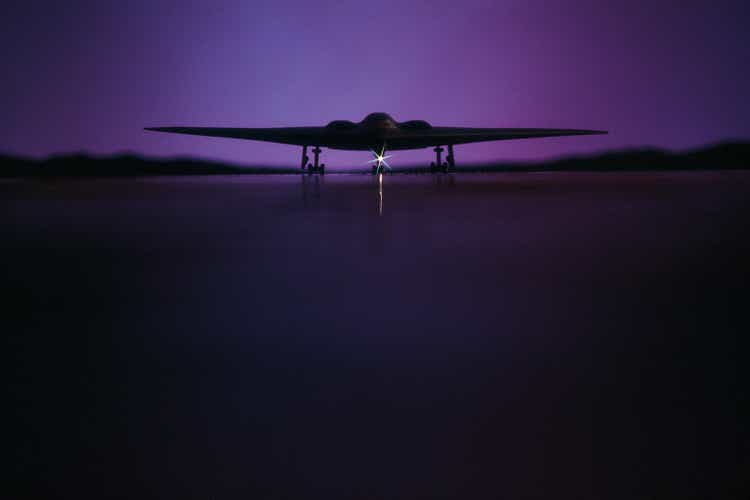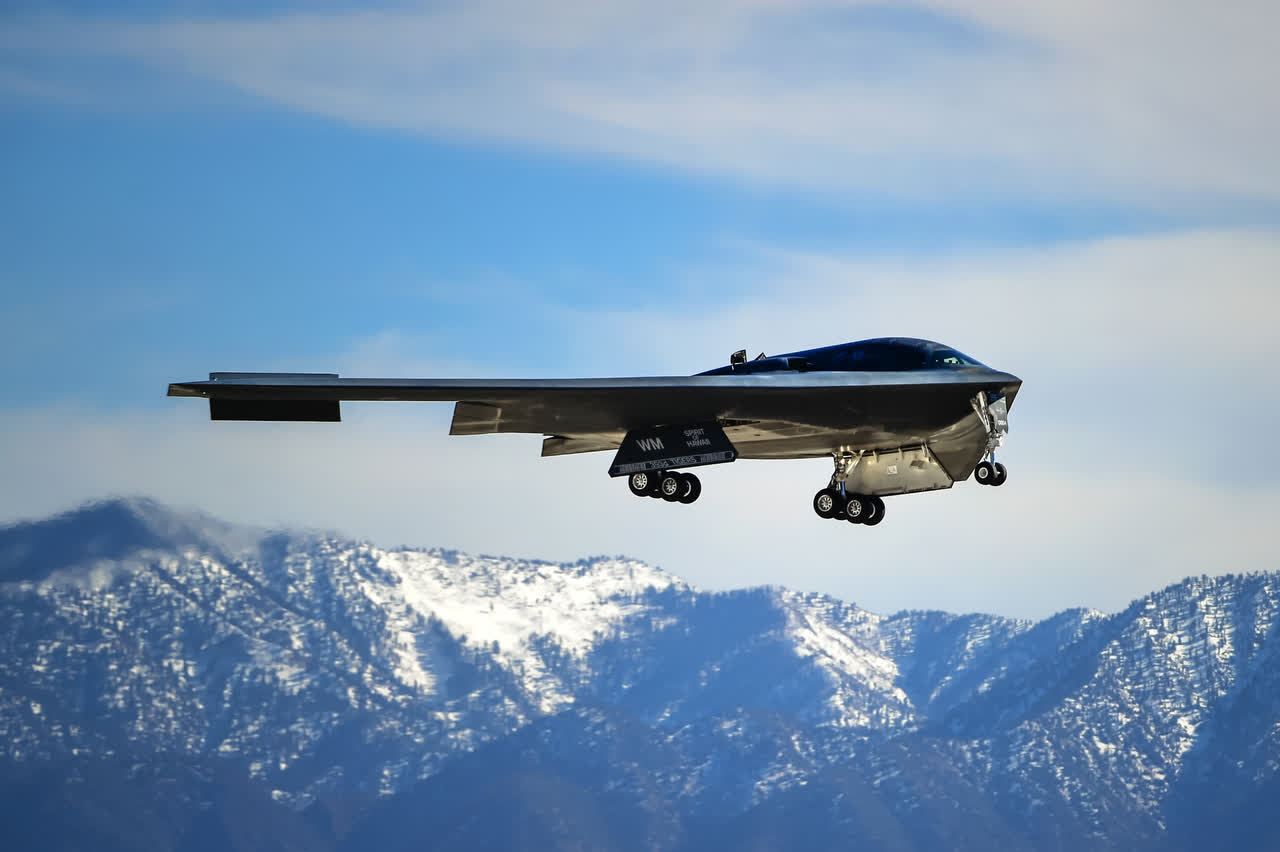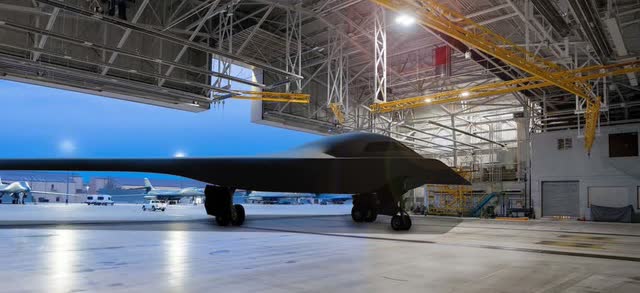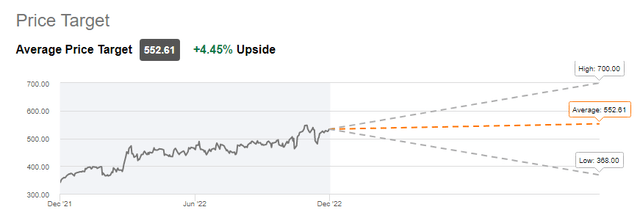
Comstock/Stockbyte via Getty Images
The second of December will be an extremely important day for the US Air Force as well as Northrop Grumman (NYSE:NOC). After years of developing, Northrop Grumman will be rolling out its next generation bomber. It’s a big event comparable to the Boeing 787 roll out in 2007 for Boeing (BA). The program has a value running in the tens of billions of dollars so it’s an incredibly important program to Northrop Grumman.
A Competitive Road To Stealth
As is the case with many defense programs, it took years to get to the point of rollout with a lot of competition and priority shifts. The stealth bomber ball started rolling in 1998. After B-2 bomber production had been shut down prematurely, the big question was whether funds should be allocated toward B-2 upgrades or a new bomber. The Air Force, by 1999, believed that it would not require a new bomber until 2037 at which point it would need aircraft as the B-1s approached the end of service life and the B-2 bomber also built by Northrop Grumman would drop below the minimum fleet levels while the B-52 bombers would also drop below minimum fleet levels required. By 2021, the loss of some mission capabilities for the B-52 would lead to a capability gap and a new acquisition program had to commence in the 2012-2015 timeframe.
By 2003, the aim had become to have a next generation bomber operational by 2018, but there were already some signs that long-range strike capability was preferred. Boeing teamed up with Lockheed Martin (LMT) for the contest and Northrop Grumman with prior knowledge from the B-2 bomber did not team up with an industry partner. By 2009, the Air Force made it clear that the required capability was long-range strike capability. Whether it was long-range strike capability or next generation bomber capability that was required, one thing was clear for a while and that regardless of the required bomber capability the party that would lose the contract would be forced out of the bomber business. So, Boeing combined its bomber capabilities with Lockheed Martin’s stealth capabilities and competed against Northrop Grumman for the long-range strike bomber contract, which would ultimately replace the B-52, B-1 and B-2.
One lesson that was learned from the B-2 bomber program is that cost should be manageable, so while a new bomber would incorporate new technological implementation those technologies should in some way be proven and mature. The B-2 bomber program should have had a production run of 132 aircraft but only 21 were eventually built due to the limited-service life pushing up the unit costs to $2 billion.
So, it was clear that costs were going to be a decisive factor and eventually, in 2015, the contract was awarded to Northrop Grumman.
Northrop Grumman’s B-21: A Strategic Top Secret
There are several reasons why the B-21 reveal is important. First of all, there are 22 years leading up to this moment, seven years since the contract award and three years since production started. Secondly, this is a step toward first flights in 2023 and eventually mission capability. This also marks the first time that the aircraft can be seen. Little details have been given about the B-21, its exact dimensions and capabilities have not been known and even contractual funds and development progress have largely been kept classified. As a tool of power projection it was important not to give too much away. The bomber reveal comes at a time of extremely high tensions with China and Russia, so in that regard the reveal is important as well, and if we look at how the threat environment has development, we can say that opting for a long-range strike capability was the right choice.
So far, we have had some renderings of the B-21 from which no details could be derived. With the reveal, I don’t expect that we will get to know a lot more about the stealth bomber. It will continue to be a program that will have a veil of secrecy regarding its capabilities. One thing we will likely be able to see is whether the USAF has opted for a smaller size bomber given how expensive the B-2 bomber had gotten. What we do know is that in the current threat environment it’s an important power projection tool for the US and extremely important for the US nuclear triad.
What is Northrop Grumman’s newest stealth bomber?

(Source: Northrup Grumman)
The big question is of course what is Northrop Grumman’s newest bomber. Details aren’t known. This project has been classified and we haven’t seen much detail on it. Even people who are tasked with cleaning the production facilities go through strict screening, so details are as one could imagine limited. The name of the bomber is B-21. There hasn’t been a lot of creativity for coming up with a name – the B part stands for bomber, the 21 stands for 21st Century. We have seen the US military come up with more creative names over the past few years.
What the bomber looks like, we don’t know either. It’s a flying-wing concept, just like the B-2, but we don’t know how many engines will power it or what the size of the bomber is. That even basic information on the propulsion system is classified is perfectly understandable. If we would have this information, we could have derived elements such as the size of the airplane and from that foreign military and intelligence agencies could have derived other items such as range, endurance and capability.
What we do know is that this bomber is a long-range strike bomber with stealth capability. So, low observability for a bomber that will be able to fly extremely far without being detected carrying nuclear bombs if needed. It will not have the sole purpose of a nuclear bomber but also will function as a conventional bomber and the biggest value will be power projection to countries such as China and Russia. The value does not lie so much in bombing other nations, but having the capability in house to do and show the world you can do it. That’s why the requirement was focused on long-range strike capability with the focus on long range. The B-2 was able to fly up to an altitude of 50,000 feet at 560 mph with up to 23 tons of payload capability for the weapon bay. While I don’t expect much detail, the size of the aircraft could provide some insight on payload capability. Furthermore, we expect state-of-the art electronic warfare capabilities, electronic countermeasures and cloud-driven data transfer enabling modern mission capabilities in the field of Intelligence, Surveillance and Reconnaissance. While in the near-term future we expect only manned flights the B-21 Raider is designed with unmanned operations in mind. So, depending on the size, we expect the B-21 to be a more modern solution: More electronic, more data, more cloud. As you would expect from a 21st century military platform.
Capitalizing on stealth: How many B-21 Raiders will be built?

US Air Force
From financial point of view, Northrop Grumman has not been able to share a lot about the program because it’s such an important program to the US capabilities that it has largely been kept classified. What we do know is that six bombers have been built so far or are in various stages of completion. The Engineering and Manufacturing development contracted awarded in 2015 was worth $12.4 billion giving somewhat of an impression of the size of this program. Eventually the plan is to acquire 100 B-21s and it’s suggested that with the B-21 being the only bomber available this could rise to 175 units.
What is the cost of a B-21 raider?
While exact pricing is not known, in 2010 dollars the aircraft should cost at most $550 million and Northrop Grumman has been meeting those expectations. Using the $550 million figure per unit multiplied by the number of units that could be procured, we have a revenue potential of $55 billion to $96.25 billion for Northrop Grumman with further expected sustainment costs down the road. The first 21 aircraft were part of the initial contract award meaning that $43 billion to $85 billion in revenue potential continues to exist.
Is Northrop Grumman stock forecasted to go up?
The initial EMD contracts are structured as cost-plus-incentive contracts meaning that Northrop Grumman is reimbursed for the costs of development and manufacturing and receives performance-based fees. Earlier this year we had some details coming in the first quarter when Northrop Grumman CEO Kathy Warden shared that they had a performance based positive adjustment of $67 million in the first quarter and the B-21 program will continue ramping up going forward. In 2023, this will still be offsetting a downturn in Aeronautics platforms but will help growth in 2024 and even with the unquantified low-rate initial production (LRIP) for B-21s under contract that Northrop Grumman does not share, profits are expected:
Based on our current projections, which run roughly through the end of this decade, we continue to expect production to be priced and profitably executed within the program’s average procurement unit cost target.
So, this is a program that should really boost Northrop Grumman’s performance. Initially B-21 growth driven by EMD and LRIP contracts overlapping will be offset by lower sales for other platforms only to return to growth in 2024 and the fixed type contracts from the B-21 will start kicking in from the production phase by 2025.

Seeking Alpha
So we do see there is room for growth, but the targets reaching into 2023 don’t go much further than less than 5% upside for Northrop Grumman and that’s also not completely unexpected as 2023 will be flat on Aeronautics and growth will materialize from 2024 onwards.
Conclusion: Stealth Growth For Northrop Grumman Stock
Not much has been shared about the B-21 and that is for good reason, you don’t want to have Russia and China tracking every step of progress on a power projection tool that is aimed to project power against these countries. So, we don’t know much about the B-21 bomber. What we do know is that it plays an incredibly big role in the US Air Force capabilities as well as the nuclear triad and for Northrop Grumman the unveiling of the B-21 also more or less overlaps with a tick up in B-21 related revenues that will start translating into growth from 2024 and unlike what we see at some defense contractors they expect to turn a profit on the production.


Be the first to comment